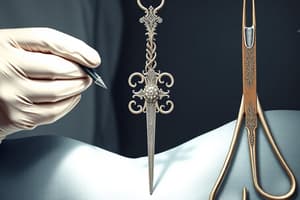Podcast
Questions and Answers
What are cutting and dissecting instruments used for?
What are cutting and dissecting instruments used for?
To cut body tissue or surgical supplies.
What is another name for straight Mayo scissors?
What is another name for straight Mayo scissors?
Suture scissors.
What type of tissue are curved Mayo scissors used to cut?
What type of tissue are curved Mayo scissors used to cut?
Heavy tissue (fascia, muscle, uterus, breast).
What is the function of a hemostat?
What is the function of a hemostat?
What is the purpose of a Kelly?
What is the purpose of a Kelly?
What other names are given to a right angle clamp?
What other names are given to a right angle clamp?
What are Allis forceps used for?
What are Allis forceps used for?
What distinguishes Russian tissue forceps?
What distinguishes Russian tissue forceps?
What are thumb forceps primarily used for?
What are thumb forceps primarily used for?
What is the primary use of Mayo-Hegar needle holders?
What is the primary use of Mayo-Hegar needle holders?
What is the purpose of retracting and exposing instruments?
What is the purpose of retracting and exposing instruments?
What type of retractor is a Deaver retractor?
What type of retractor is a Deaver retractor?
What are the two types of retractors mentioned?
What are the two types of retractors mentioned?
Flashcards
Mayo Scissors
Mayo Scissors
Surgical scissors used for cutting tissues.
Metzenbaum Scissors
Metzenbaum Scissors
Scissors for cutting delicate tissues.
Hemostat
Hemostat
Instrument for clamping blood vessels.
Mosquito
Mosquito
Signup and view all the flashcards
Kelly Clamp
Kelly Clamp
Signup and view all the flashcards
Allis Grasping Forceps
Allis Grasping Forceps
Signup and view all the flashcards
Babcock Grasping Forceps
Babcock Grasping Forceps
Signup and view all the flashcards
Mayo-Hegar Needle Holders
Mayo-Hegar Needle Holders
Signup and view all the flashcards
Deaver Retractor
Deaver Retractor
Signup and view all the flashcards
Army-Navy Retractor
Army-Navy Retractor
Signup and view all the flashcards
Study Notes
Cutting and Dissecting Instruments
- Sharp instruments used for cutting tissues or surgical supplies.
- Straight Mayo Scissors: Primarily used for cutting sutures; also known as suture scissors.
- Curved Mayo Scissors: Designed for cutting heavy tissues like fascia and muscle; available in regular and long sizes.
- Metzenbaum Scissors: Ideal for cutting delicate tissues; also available in regular and long sizes.
Clamping and Occluding Instruments
- Used to compress blood vessels or hollow organs to achieve hemostasis or prevent spillage.
- Hemostat: Clamps blood vessels, comes with straight or curved jaws; also known as crile or snap.
- Mosquito: Designed for clamping small blood vessels with straight or curved jaws.
- Kelly: Used for larger vessels and tissue; available in short and long sizes; also known as Rochester Pean.
- Burlisher: Clamps deeper blood vessels, has two closed finger rings; open finger ring version called tonsil hemostat.
- Right Angle: Clamps hard-to-reach vessels and aids in suturing; referred to as "tie on a passer" when a suture is attached.
- Hemoclip Applier: Applies metal clips to blood vessels for occlusion.
Grasping Instruments
- Instruments designed to hold or grasp tissues during surgery.
- Allis: Grasp tissue, available in short and long sizes; variations include Judd-Allis for intestinal tissue and heavy allis for breast tissue.
- Babcock: Used for grasping delicate tissues like intestine or ovaries; also available in different sizes.
- Kocher: Grasp heavy tissue and can be used as a clamp; available with straight or curved jaws, also called Ochsner.
- Foerster Sponge Stick: Grasp sponges; also known as sponge forceps.
- Backhaus Towel Clip: Holds towels and drapes in place; commonly referred to as towel clip.
- Pick Ups, Thumb Forceps, and Tissue Forceps: Various lengths, available with or without teeth; smooth or serrated jaws.
- Russian Tissue Forceps: Specifically designed for grasping tissue.
- Adson Pick Ups: Smooth for delicate tissue or with teeth for skin grasping; also known as Dura forceps.
- Thumb Forceps: Grasp tough tissues like fascia; available as single tooth or many teeth; single tooth known as rat tooth forceps.
Needle Holders and Retracting Instruments
- Mayo-Hegar Needle Holders: Hold needles during suturing; may be classified under sewing instruments.
- Retracting instruments hold back tissues for better exposure during surgery; classified as self-retaining or manual based on functionality.
- Deaver Retractor: Manual retractor for deep abdominal or chest incisions; available in various widths.
- Richardson Retractor: Another manual option for retracting deep incisions.
- Army-Navy Retractor: Manual retractor for shallow incisions; also known as USA or US Army.
- Goulet Retractor: Used for shallow incisions manually.
- Malleable or Ribbon Retractor: Can be bent into various shapes to retract deep wounds manually.
- Weitlaner Retractor: Self-retaining, used for shallow incisions.
- Gelpi Retractor: Another self-retaining option for shallow incision retraction.
Studying That Suits You
Use AI to generate personalized quizzes and flashcards to suit your learning preferences.




